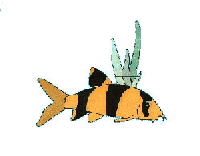ASHTABULA COUNTY AQUARIUM CLUB


Cichlosoma octofasciatum
(Jack dempsey)
by: Elsie Swanson
My experiences on spawning Cichlosoma octofasciatum (AKA - Jack dempsey)was a successful venture..
I purchased a breeding pair at the GAAS fall auction on November 1, 1998. This is an easy way to obtain a pair. The bag was labeled "breeding pair" now that is the easy part, but what they don't tell you is: Does this pair take care of the eggs? Do they take care of the wigglers? Do they take care of the free swimming fry? This is where the trial and error in any spawns begin, and is how we learn.
We brought them home and placed them alone in a 10gallon tank. The tank was bare, we gave them a large flat rock, an empty 3# butter bowl (clean of course) with an arch cut into the side of it, placed it upside down in the tank, like a cave with a piece of slate laying in it. The tank was 82 degrees, and had an outside filter.
I wasn't expecting anything to happen as quick as it did but 4 days later {Nov. 5th} the rock was covered with eggs, approximately 300. Now faced with the decision of leaving the eggs with the parents or to pull them and attempt to hatch them on our own? We chose to leave them with the parents - and if all else failed we would try again. Well they failed - after three days they had wigglers {Nov. 7th} and then on day 5 they had lunch, there was none left in the tank. It was so neat the way that she carried off the fungused eggs in her mouth depositing them in an unoccupied corner of the tank, I thought for sure she was going to be the mother of the year! Perhaps I spooked them trying to remove this mess that she had so neatly piled up.
A week later I did a water change and continued to feed them well (four times a day) with a variety of foods. A few days following the water change I was sitting about 6 feet away from the tank, when I heard a thud and a splash. One of them leaped and hit the lid on the tank. I observed them for about 20 minutes after that. The female was almost all black in color, they were locking lips, circling each other, biting each others sides, chasing, jumping, they were really aggressive in this pre spawning behavior. Well the very next day {Nov. 18th} I went to feed all of our tanks, when I got to their tank I was greeted by both of them, they wouldn't take their eyes off of me then the female retreated to the butter bowl, fanning her eggs. We again chose to leave them with the parents. Nov. 21st - wigglers, Nov. 24th swimmers. I fed some frozen baby brine several times a day, but the anxiety got the best of us, we were really excited about the spawn, especially being our second substrate cichlid spawn anyway. We pulled the babies, well most of them. We left the parents about 50. We had about 150. December 31st, we have about 50 left, they still have their 50. The funny thing is that the ones they had were three times larger then the ones we took. I took the rest of theirs away and turned some in for our BAP points.
January 5th, eggs again, January 8th - wigglers, January 12th swimmers. I expect that this spawn will be a great success, since now that I've read several articles on the Jack Dempseys, and one things it seems that many hobbyists agree upon is that Jack Dempseys are excellent parents.
Jack Dempseys are from Central Amazon Basin (Central America} They grow to about 8-10", tolerating water 72-78 degrees (80 - 82degrees for spawning) pH 6.5-7.2
It is not easy to tell the difference between females and males, They both change their color with their mood. Males have longer dorsal and anal fins. The males dorsal fin is more pointy then the females